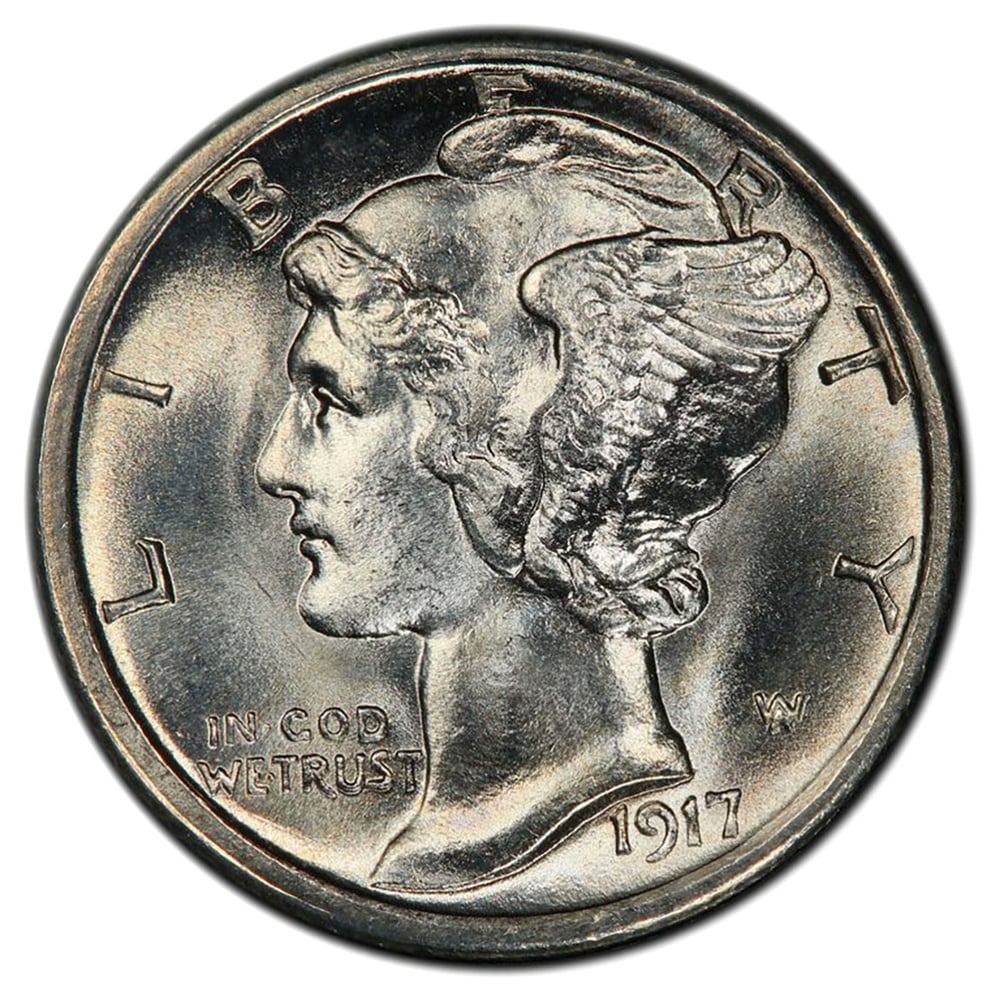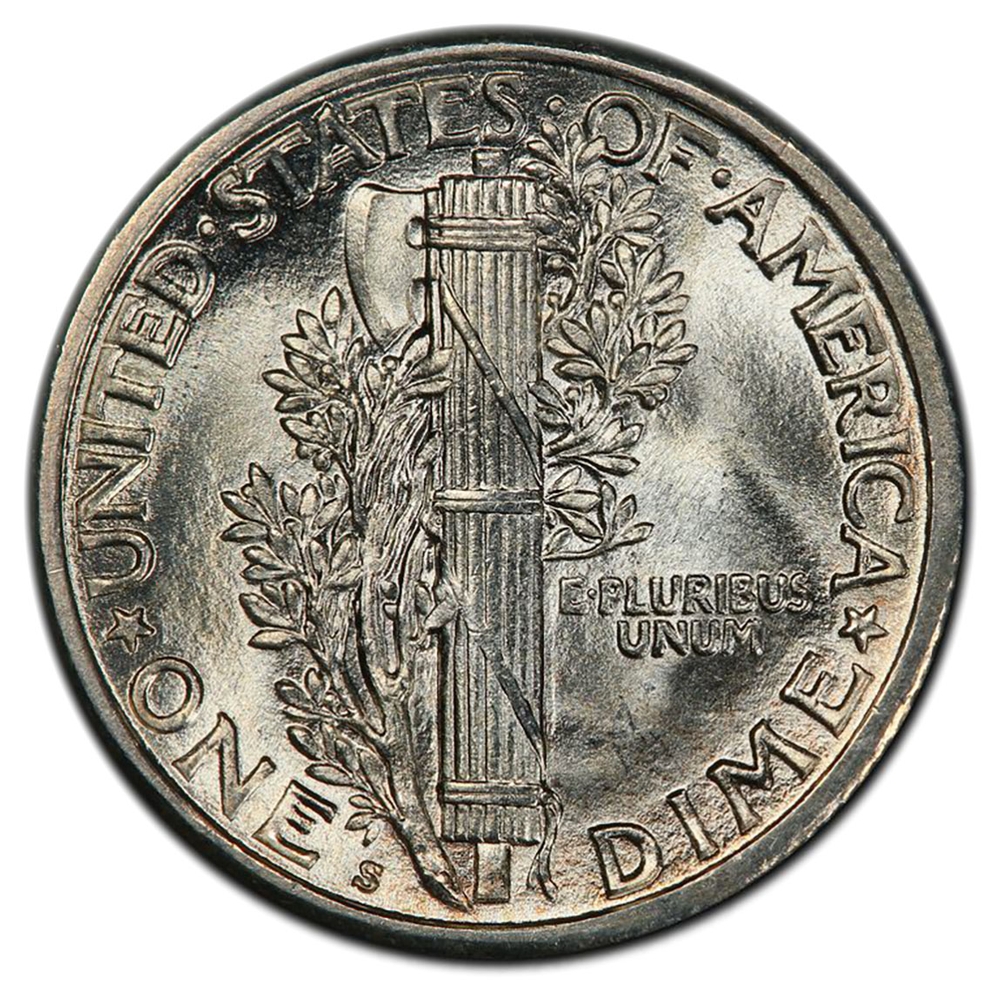About Numiis / Numis DB
The numismatic database project is designed to provide all information any coin collector or numismatist would need regarding a coin, medal or note of interest.
The mercury dime value ranges from $1 to $100,000 depending on the quality of the coin, which year it was minted in, which mint it was manufactured at, and its strike type.


Many consider the Winged Liberty Head dime, popularly known as the "Mercury dime", the most attractive U.S. 10-cent coin. The Winged Liberty Head dime was among the last of the coins introduced during America's Golden Age of coinage, which began around 1906 when President Roosevelt invited Augustus Saint-Gaudens to redesign the $10 eagle and $20 double eagle.
In 1916, sculptor Adolph A. Weinman produced a new design for the dime called the Liberty Head type. The motif features Miss Liberty facing left, wearing a Phrygian cap with wings, symbolizing "liberty of thought". The word "LIBERTY" encircles her head, with "IN GOD WE TRUST" and the date below her head.
The reverse depicts Roman fasces, a bundle of rods with the center rod being an ax, against a branch in the background. It is a symbol of state authority, which offers a choice: "by the rod or by the ax". The condemned was either beaten to death with the rods or allowed the mercy of the ax. The words "UNITED STATES OF AMERICA" and "ONE DIME" surround the border. "E PLURIBUS UNUM" appears at the lower right.
Shortly after the dime began circulating, many began calling it the Mercury dime due to the wings on the cap. Mercury is Roman God of commerce, property and wealth as well as the messenger to the gods. Mercury is often depicted wearing a broad brimmed hat bearing wings. The hat, called a Petasus, is similar to that worn by messengers during the time when Mercury was worshipped. Mercury gained his speed from the small winged sandals he wore.
The figure on Adolph A. Weinman's dime was actually based on a bust of Elsie Stevens, the young wife of poet Wallace Stevens. The artist-sculptor asked Elsie to pose for a sculpture bust around 1913. Weinman used his bust of Elsie Stevens as a model for the dime, when he began designing it in 1915. A profile photograph of the bust shows the obvious inspiration for the dime. The whereabouts of Weinman's bust is unknown. It disappeared after Wallace Stevens' death, and after their daughter declined to accept it as a gift from her mother.
The design was continued without change through 1945. The coin was minted at the Philadelphia, Denver, and San Francisco mints. Proofs were made at the Philadelphia Mint from 1936 through 1942.
ID: 32
 1916 Mercury 10c Ms
Mint Strike
1916 Mercury 10c Ms
Mint Strike
 1916 S Mercury 10c Ms
Mint Strike
1916 S Mercury 10c Ms
Mint Strike
 1916 D 10c Ms
Mint Strike
1916 D 10c Ms
Mint Strike
 1917 10c Ms
Mint Strike
1917 10c Ms
Mint Strike
 1917 S 10c Ms
Mint Strike
1917 S 10c Ms
Mint Strike
 1917 D 10c Ms
Mint Strike
1917 D 10c Ms
Mint Strike
 1918 10c Ms
Mint Strike
1918 10c Ms
Mint Strike
 1918 S 10c Ms
Mint Strike
1918 S 10c Ms
Mint Strike
 1918 D 10c Ms
Mint Strike
1918 D 10c Ms
Mint Strike
 1919 10c Ms
Mint Strike
1919 10c Ms
Mint Strike
 1919 S 10c Ms
Mint Strike
1919 S 10c Ms
Mint Strike
 1919 D 10c Ms
Mint Strike
1919 D 10c Ms
Mint Strike
 1920 10c Ms
Mint Strike
1920 10c Ms
Mint Strike
 1920 S 10c Ms
Mint Strike
1920 S 10c Ms
Mint Strike
 1920 D 10c Ms
Mint Strike
1920 D 10c Ms
Mint Strike
 1921 10c Ms
Mint Strike
1921 10c Ms
Mint Strike
 1921 D 10c Ms
Mint Strike
1921 D 10c Ms
Mint Strike
 1923 10c Ms
Mint Strike
1923 10c Ms
Mint Strike
 1923 S 10c Ms
Mint Strike
1923 S 10c Ms
Mint Strike
 1924 10c Ms
Mint Strike
1924 10c Ms
Mint Strike
 1924 S 10c Ms
Mint Strike
1924 S 10c Ms
Mint Strike
 1924 D 10c Ms
Mint Strike
1924 D 10c Ms
Mint Strike
 1925 10c Ms
Mint Strike
1925 10c Ms
Mint Strike
 1925 S 10c Ms
Mint Strike
1925 S 10c Ms
Mint Strike
 1925 D 10c Ms
Mint Strike
1925 D 10c Ms
Mint Strike
 1926 10c Ms
Mint Strike
1926 10c Ms
Mint Strike
 1926 S 10c Ms
Mint Strike
1926 S 10c Ms
Mint Strike
 1926 D 10c Ms
Mint Strike
1926 D 10c Ms
Mint Strike
 1927 10c Ms
Mint Strike
1927 10c Ms
Mint Strike
 1927 S 10c Ms
Mint Strike
1927 S 10c Ms
Mint Strike
 1927 D 10c Ms
Mint Strike
1927 D 10c Ms
Mint Strike
 1928 10c Ms
Mint Strike
1928 10c Ms
Mint Strike
 1928 S 10c Ms
Mint Strike
1928 S 10c Ms
Mint Strike
 1928 D 10c Ms
Mint Strike
1928 D 10c Ms
Mint Strike
 1929 10c Ms
Mint Strike
1929 10c Ms
Mint Strike
 1929 S 10c Ms
Mint Strike
1929 S 10c Ms
Mint Strike
 1929 D 10c Ms
Mint Strike
1929 D 10c Ms
Mint Strike
 1930 10c Ms
Mint Strike
1930 10c Ms
Mint Strike
 1930 S 10c Ms
Mint Strike
1930 S 10c Ms
Mint Strike
 1931 10c Ms
Mint Strike
1931 10c Ms
Mint Strike
 1931 S 10c Ms
Mint Strike
1931 S 10c Ms
Mint Strike
 1931 D 10c Ms
Mint Strike
1931 D 10c Ms
Mint Strike
 1934 10c Ms
Mint Strike
1934 10c Ms
Mint Strike
 1934 D 10c Ms
Mint Strike
1934 D 10c Ms
Mint Strike
 1935 10c Ms
Mint Strike
1935 10c Ms
Mint Strike
 1935 S 10c Ms
Mint Strike
1935 S 10c Ms
Mint Strike
 1935 D 10c Ms
Mint Strike
1935 D 10c Ms
Mint Strike
 1936 10c Ms
Mint Strike
1936 10c Ms
Mint Strike
 1936 10c Pf
Proof
1936 10c Pf
Proof
 1936 S 10c Ms
Mint Strike
1936 S 10c Ms
Mint Strike
 1936 D 10c Ms
Mint Strike
1936 D 10c Ms
Mint Strike
 1937 10c Ms
Mint Strike
1937 10c Ms
Mint Strike
 1937 10c Pf
Proof
1937 10c Pf
Proof
 1937 S 10c Ms
Mint Strike
1937 S 10c Ms
Mint Strike
 1937 D 10c Ms
Mint Strike
1937 D 10c Ms
Mint Strike
 1938 10c Ms
Mint Strike
1938 10c Ms
Mint Strike
 1938 10c Pf
Proof
1938 10c Pf
Proof
 1938 S 10c Ms
Mint Strike
1938 S 10c Ms
Mint Strike
 1938 D 10c Ms
Mint Strike
1938 D 10c Ms
Mint Strike
 1939 10c Ms
Mint Strike
1939 10c Ms
Mint Strike
 1939 10c Pf
Proof
1939 10c Pf
Proof
 1939 S 10c Ms
Mint Strike
1939 S 10c Ms
Mint Strike
 1939 D 10c Ms
Mint Strike
1939 D 10c Ms
Mint Strike
 1940 10c Ms
Mint Strike
1940 10c Ms
Mint Strike
 1940 10c Pf
Proof
1940 10c Pf
Proof
 1940 S 10c Ms
Mint Strike
1940 S 10c Ms
Mint Strike
 1940 D 10c Ms
Mint Strike
1940 D 10c Ms
Mint Strike
 1941 10c Ms
Mint Strike
1941 10c Ms
Mint Strike
 1941 10c Pf
Proof
1941 10c Pf
Proof
 1941 S 10c Ms
Mint Strike
1941 S 10c Ms
Mint Strike
 1941 D 10c Ms
Mint Strike
1941 D 10c Ms
Mint Strike
 1942 10c Ms
Mint Strike
1942 10c Ms
Mint Strike
 1942/41 10c Ms
Mint Strike
1942/41 10c Ms
Mint Strike
 1942 10c Pf
Proof
1942 10c Pf
Proof
 1942 S 10c Ms
Mint Strike
1942 S 10c Ms
Mint Strike
 1942 D 10c Ms
Mint Strike
1942 D 10c Ms
Mint Strike
 1942/41 D 10c Ms
Mint Strike
1942/41 D 10c Ms
Mint Strike
 1943 10c Ms
Mint Strike
1943 10c Ms
Mint Strike
 1943 S 10c Ms
Mint Strike
1943 S 10c Ms
Mint Strike
 1943 D 10c Ms
Mint Strike
1943 D 10c Ms
Mint Strike
 1944 10c Ms
Mint Strike
1944 10c Ms
Mint Strike
 1944 S 10c Ms
Mint Strike
1944 S 10c Ms
Mint Strike
 1944 D 10c Ms
Mint Strike
1944 D 10c Ms
Mint Strike
 1945 10c Ms
Mint Strike
1945 10c Ms
Mint Strike
 1945 S 10c Ms
Mint Strike
1945 S 10c Ms
Mint Strike
 1945 S Micro S 10c Ms
Mint Strike
1945 S Micro S 10c Ms
Mint Strike
 1945 D 10c Ms
Mint Strike
1945 D 10c Ms
Mint Strike
Sign up for exclusive access to the latest price trends, intelligence, auctions and more!
Gold $1,865.28 |
Silver $25.56 |
Platinum $998.24 |
Palladium $2,326.45
(Updated 2020-12-22)